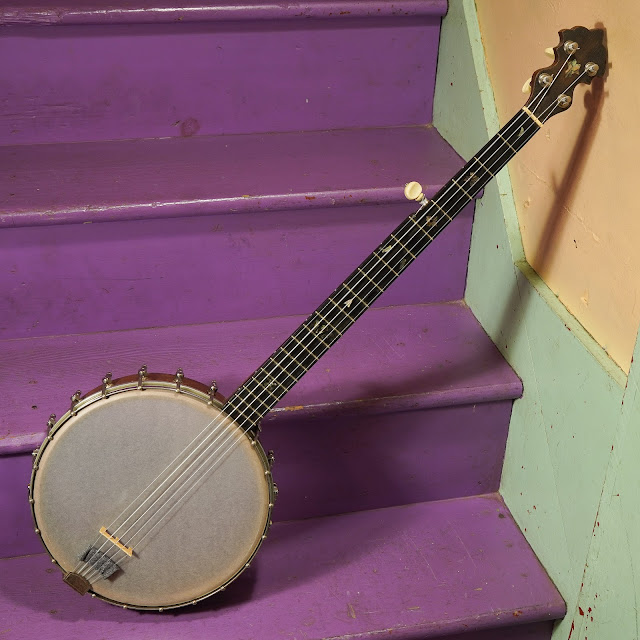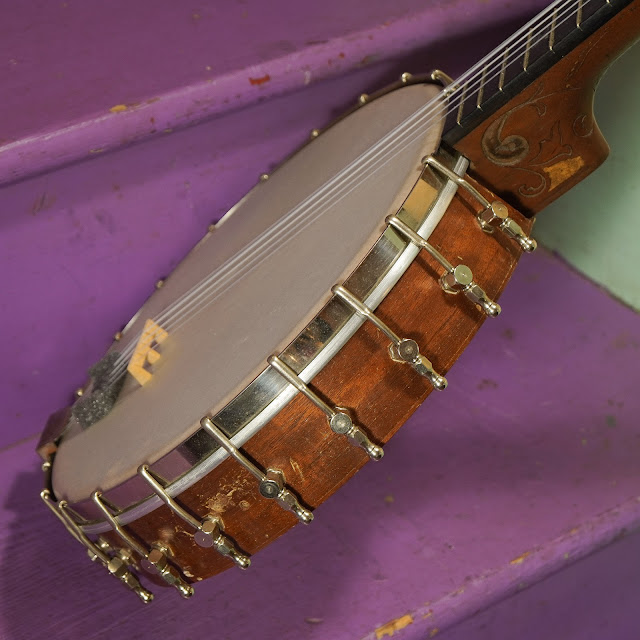1890s/1930s Stewartish/Kay 5-String Openback Partser Banjo
Here's the second partser-banjo I made (mostly) from a big box of banjo parts. It's an unmarked, 1880s/1890s 5-string neck fit to a 1930s Kay-made rim. As you might expect, since it's strung with nylgut, it sounds an awful lot like the 1890s-ish banjo it started-out as, though the multi-ply maple Kay rim has a bit more pop and less overring than your average "spunover" late-1800s rim.
Cobbling was straightforward as the neck had already been made to work "Gibson-style" in a two-bolt fashion. I modified that a little into a one-bolt setup plus two stabilizing screws, then added a "dowel veneer" to the rear of the rim to add a little extra rim stability and so the eyes wouldn't abandon hope when seeing nothing back there. It was perfectly happy strung-up and tuned without it, though, heh heh...
I'm really happy with how it turned-out -- it's rugged, practical, and plays and sounds a treat. It could probably handle steel strings in a pinch (it was strung-up with 9s for years in its past life) but I like the sound and feel of it with the Nylguts.
Repairs included: mating parts, a fret level/dress, side dots, fresh Remo Renaissance head install, cleaning, and setup.
Rim wood: ply maple w/mahogany veneer
Tonering: none
Bridge: one-piece maple
Fretboard: ebony (thick)
Neck wood: not quite sure -- thinking cherry stained to look like mahogany
Action height at 12th fret: 3/32” overall (fast, spot-on)
String gauges: aquila nylguts
Neck shape: medium-deeper V
Board radius: flat
Neck relief: straight
Fret style: narrow/lower
Scale length: 26 7/8"
Nut width: 1 3/16"
Head diameter: 11”
Depth overall at rim: 2 1/2"
Weight: 3 lbs 9 oz
Condition notes: all parts and hardware are actually in pretty good shape. The rim hardware is almost all original to the rim, though the tailpiece and endbolt are replacements. The neck is affixed with a big hex-nut bolt and two smaller stabilizer screws (real strong joint) and the dowel (not original to either instrument, but 1920s and Lange-made) is fit mostly for looks but does add a little cross-rim stability. In the past this neck had its dowel sawn-off to fit a different rim and so it had been mounted Gibson-style before. The tuners are all antique friction pegs and work just fine, but for constant use I definitely suggest having me fit geared pegs. As per the usual, this whole thing is made from old stuff -- so there will be small scratches, nicks, dings, etc. throughout the finish. Also, the tailpiece has to be angled a lot to line-up with the neck's path. I could relocate the endbolt to directly under it if desired.
It comes with: sorry, no case.



















Comments